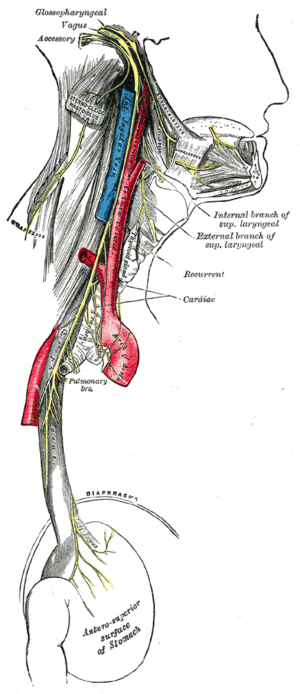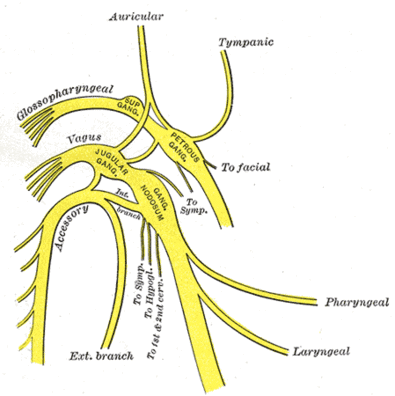Vagus Nerve
Top Contributors - Kanza Imtiaz, Lucinda hampton and Tony Lowe
This article is currently under review and may not be up to date. Please come back soon to see the finished work! (31/01/2021)
Introduction[edit | edit source]
The vagus nerve is the tenth cranial nerve (CN X) and is the longest mixed cranial nerve. The literal translation of the vagus is 'wanderer,' which aptly represents its widespread interfacing of cortex, brainstem, hypothalamus, and the body. Its afferent and efferent pathways comprise about 80% and 20%, respectively[1].
The vagus nerve runs from the brain through the face and thorax to the abdomen. It is a mixed nerve that contains parasympathetic fibres.
The vagus nerve has two sensory ganglia (masses of nerve tissue that transmit sensory impulses): the superior and the inferior ganglia.
- The branches of the superior ganglion innervate the skin in the concha of the ear.
- The inferior ganglion gives off two branches: the pharyngeal nerve and the superior laryngeal nerve.
The recurrent laryngeal nerve branches from the vagus in the lower neck and upper thorax to innervate the muscles of the larynx (voice box).
The vagus also gives off cardiac, esophageal, and pulmonary branches.
In the abdomen the vagus innervates the greater part of the digestive tract and other abdominal viscera[2].
The accessory nerve (CN XI) joins the vagus nerve just distal to the inferior ganglion.[3]
Structure and Function[edit | edit source]
The vagus nerve contains somatic and visceral afferent fibers, as well as general and special visceral efferent fibers.[4] See Table Below:
| Components | Function | Central component | Cell bodies |
|---|---|---|---|
| Special Visceral Efferent | Swallowing and phonation[4] | Nucleus ambiguus | Nucleus ambiguus |
| General Visceral Efferent | Involuntary muscle control (cardiac, pulmonary, esophageal)
Innervation to glands throughout the gastrointestinal tract[4] |
Dorsal motor nucleus | Dorsal motor nucleus |
| Special Visceral Afferent | Sensations of taste from the tongue and epiglottis [4] | Nucleus tractus solitarius | Inferior ganglion |
| General Visceral Afferent | Sensations from the pharynx, larynx, trachea, esophagus, and the abdominal and thoracic viscera[4] | Nucleus tractus solitarius | Inferior ganglion |
| General Somatic Afferent | Innervation to the external ear and tympanic membrane[4] | Nucleus of the spinal tract of trigeminal | Superior ganglion |
Course[edit | edit source]
The Vagus nerveExits the brain from the medulla oblongata of the brainstem and travels laterally exiting the skull through the jugular foramen.
It descends within the carotid sheath where it is located posterolateral to the internal and common carotid arteries, and medial to the internal jugular vein.
At the base of the neck, the nerve enters the thorax, where the right and left vagus nerve travels on a different path. [7]
- The right vagus enters the thorax by crossing the first part of the subclavian artery and posterior to the innominate artery; then travels behind the primary right bronchus and esophagus to form the esophageal plexus with the left vagus nerve. [8]
- The left vagus enters the thorax by passing between the left common carotid and left subclavian arteries, then travels behind the primary left bronchus and into the esophagus.[8]
Clinical Significance[edit | edit source]
The vagus nerve is commonly tested clinically by comparing the palatal arches on the two sides. A patient is often asked to open their mouth and say ‘ah,’ as this should cause elevation of the uvula. On the paralyzed side, there is no arching and the uvula is pulled to the normal side.
As the vagus nerve and its branches supply many different structures in the body, a lesion along the course of the vagus nerve can cause different symptoms that may vary from palatal and pharyngeal paralysis to abnormalities in the gastric acid secretion and heart rate.
Vasovagal syncope is one of the most common causes of fainting, which is due to the vagus nerve. For example, during a period of an unusual stimulus such as emotional stress, the body overreacts and causes the vagus nerve to a sudden drop in blood pressure and heart rate. A vasovagal syncope doesn't require a specific medical treatment but should be consulted to a physician if repeated episodes of syncope occur. Furthermore, a carotid massage may compress the carotid sinus leading to the perception of high blood pressure.
Unilateral damage to the pharyngeal branch may cause dysphagia. Lesions of the superior pharyngeal nerve results in paralysis of cricothyroid muscle and anesthesia in the upper part of the larynx. [9]
Irritation of the auricular branch in the external ear may cause chronic cough (ear-cough reflex or Arnold's nerve ear-cough reflex). In children, enlarged lymph nodes may also irritate the recurrent laryngeal nerve and cause a persistent cough.[10]
An injury to the recurrent laryngeal nerve as a result of trauma, surgery, or a large tumor results in hoarseness and dysphonia due to the paralysis of the right vocal cord. [11]
Paralysis of both the vocal cords results in inspiratory stridor and aphonia and is very likely to occur in thyroid surgery.[12]
A paralyzed vagus nerve also produces:
- nasal regurgitation of swallowed liquid
- hypernasal speech
- dysarthria
- flattening of the palatal arch
- uvula deviation
- cadaveric position of the vocal cord[9]
Resources[edit | edit source]
Vagus nerve stimulation
References[edit | edit source]
- ↑ Mandalaneni K, Rayi A. Vagus nerve stimulator. StatPearls [Internet]. 2020 Aug 20.Available from: https://www.ncbi.nlm.nih.gov/books/NBK562175/(accessed 31.1.2021)
- ↑ Britannica Vagus Nerve Available from: https://www.britannica.com/science/vagus-nerve (accessed 31.1.2021)
- ↑ Berthoud HR, Neuhuber WL. Functional and chemical anatomy of the afferent vagal system. Autonomic Neuroscience. 2000 Dec 20;85(1-3):1-7.
- ↑ 4.0 4.1 4.2 4.3 4.4 4.5 Kenny BJ, Bordoni B. Neuroanatomy, Cranial Nerve 10 (Vagus Nerve). InStatPearls [Internet] 2019 Jan 25. StatPearls Publishing.
- ↑ Kenhub - Learn Human Anatomy. Vagus nerve: location, branches and function (preview) - Neuroanatomy | Kenhub. Available from: https://www.youtube.com/watch?v=bNPfjLnnJzA [last accessed 23/9/2020]
- ↑ The Art of Living. What Is The Vagus Nerve? | Vagus Nerve Explained | Brain, Mind Body Connect. Available from: https://www.youtube.com/watch?v=gp67EQhNfj8 [last accessed 23/9/2020]
- ↑ Garner DH, Baker S. Anatomy, Head and Neck, Carotid Sheath. InStatPearls [Internet] 2019 Feb 6. StatPearls Publishing.
- ↑ 8.0 8.1 Yuan H, Silberstein SD. Vagus nerve and vagus nerve stimulation, a comprehensive review: part II. Headache: The Journal of Head and Face Pain. 2016 Feb;56(2):259-66.
- ↑ 9.0 9.1 Erman AB, Kejner AE, Hogikyan ND, Feldman EL. Disorders of cranial nerves IX and X. InSeminars in neurology 2009 Feb (Vol. 29, No. 1, p. 85). NIH Public Access.
- ↑ Dicpinigaitis PV, Kantar A, Enilari O, Paravati F. Prevalence of Arnold nerve reflex in adults and children with chronic cough. Chest. 2018 Mar 1;153(3):675-9.
- ↑ Montoya S, Portanova A, Bhatt AA. A radiologic review of hoarse voice from anatomic and neurologic perspectives. Insights into imaging. 2019 Dec;10(1):1-21.
- ↑ Hayward NJ, Grodski S, Yeung M, Johnson WR, Serpell J. Recurrent laryngeal nerve injury in thyroid surgery: a review. ANZ Journal of Surgery. 2013 Jan;83(1-2):15-21.








